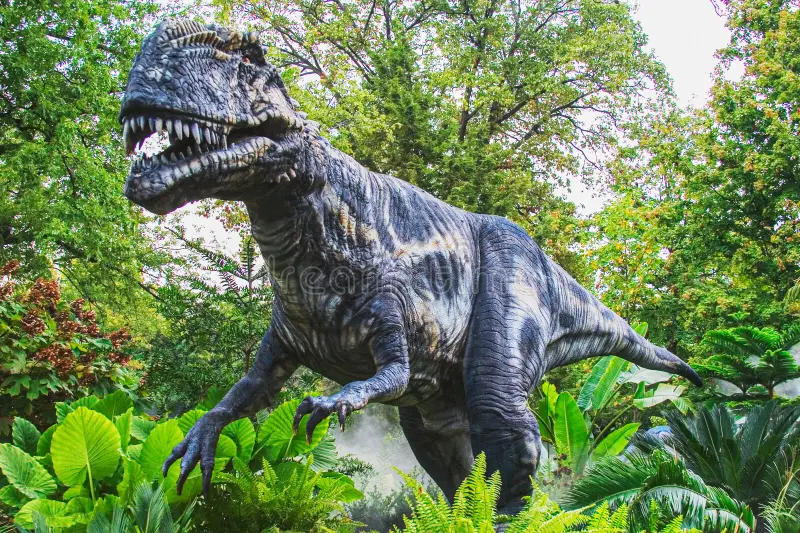The Discovery of Megalosaurus
The story of the Megalosaurus began in the early 1800s. In 1824, a group of scientists discovered some large bones in England. They realized these bones belonged to a giant creature that once walked the Earth. The bones were unique and unlike anything they had seen before, so they named this creature Megalosaurus. This discovery was very important because it was one of the first times scientists studied dinosaur bones. It sparked interest in dinosaurs, leading to more discoveries and studies in paleontology, the science of studying ancient life.
What Did the Megalosaurus Look Like?
The Megalosaurus was a large dinosaur that could grow up to 30 feet long! Imagine a small bus! It stood on two strong legs and had a long tail that helped it balance. Its head was big and filled with sharp teeth, perfect for catching prey. The Megalosaurus had three large fingers on each hand, which helped it grab its food. It had strong legs that allowed it to run fast, which was essential for hunting. With its impressive size and sharp features, the Megalosaurus was a fierce predator in its time.
Where Did the Megalosaurus Live?
Megalosaurs roamed the Earth during the Jurassic period, about 166 million years ago. This was a time when the world looked very different. The climate was warm, and lush forests covered the land. These forests were home to many plants and other animals, making it an ideal place for the Megalosaurus to live. Megalosaurus fossils have been found in parts of England, France, and even some other places in Europe. This tells us that it lived in a variety of environments, from forests to open areas.
The Diet of the Megalosaurus
What did the Megalosaurus eat? As a carnivore, the Megalosaurus loved to eat meat! It hunted other dinosaurs and animals that lived around it. Scientists believe that it may have hunted smaller dinosaurs or scavenged on the carcasses of larger ones. With its sharp teeth and powerful jaws, the Megalosaurus was a skilled predator. It had to be quick and smart to catch its food. Imagine being in a race with other dinosaurs; the Megalosaurus had to be fast to get its dinner!
How Did Megalosaurus Hunt?
Hunting for food wasn’t just about running fast; it was also about using clever strategies. The Megalosaurus likely used its strong legs to sneak up on its prey. It may have waited patiently, hiding among the bushes, then pounced at just the right moment. Some scientists believe it might have hunted in groups, similar to how some animals do today. Working together would allow them to take down larger prey. This teamwork shows us that even dinosaurs had their own ways of cooperating to survive.
The Life Cycle of Megalosaurus
Like all living creatures, the Megalosaurus had a life cycle. It began as a tiny egg, just like a baby bird. When the eggs hatched, baby Megalosauruses, called hatchlings, came out. These young dinosaurs were small and vulnerable, needing their parents’ protection. As they grew, they learned to hunt and fend for themselves. Megalosaurus babies had to grow quickly because the world was full of dangers, including other predators. Their growth would take several years until they became fully grown adults, ready to take on the challenges of their environment.
The Role of Megalosaurus in Its Ecosystem
Every creature has a role to play in its environment, and the Megalosaurus was no exception. As a top predator, it helped keep the population of other animals in check. By hunting herbivores, the Megalosaurus ensured that plants didn’t get eaten too much, allowing the ecosystem to thrive. This balance is crucial for maintaining a healthy environment. When predators like the Megalosaurus are removed from the ecosystem, it can lead to overpopulation of certain species and disrupt the natural order.
Megalosaurus and Other Dinosaurs
The Megalosaurus wasn’t the only dinosaur around during its time. It lived alongside many other species, each with its unique characteristics. Some were small and quick, while others were enormous and slow. This variety created a rich ecosystem where different dinosaurs could coexist. The Megalosaurus had to compete with other predators for food and territory. This competition led to different hunting strategies and adaptations, helping the Megalosaurus become a successful predator.
Fossils and What They Tell Us
Fossils are like nature’s time capsules, providing us with important clues about how dinosaurs lived. Scientists study Megalosaurus fossils to learn about its size, diet, and lifestyle. By examining bones and teeth, they can understand how the Megalosaurus hunted and what it ate. Fossils can also show us how the environment changed over millions of years. Each discovery helps piece together the puzzle of what life was like during the Jurassic period.
The Legacy of Megalosaurus
The Megalosaurus has left a significant mark on our understanding of dinosaurs. Being one of the first dinosaurs to be scientifically described, it opened the door to the study of these ancient creatures. Its discovery ignited interest in paleontology, leading to further explorations and research. Today, the Megalosaurus is often featured in museums and documentaries, captivating the imaginations of people of all ages. It reminds us of the wonders of our planet’s history and the amazing creatures that once roamed the Earth.
Megalosaurus in Popular Culture
You might have seen the Megalosaurus in movies, books, and toys. Its fierce appearance and dinosaur status make it a popular choice in various forms of entertainment. In films, the Megalosaurus is often depicted as a fearsome predator, which captures the excitement of dinosaur adventures. These portrayals spark curiosity in children and adults alike, encouraging them to learn more about these incredible creatures. The Megalosaurus remains a beloved character in the world of dinosaurs.
How to Learn More About Megalosaurus
If you want to learn more about the Megalosaurus, there are many ways to explore! Visiting a local museum with dinosaur exhibits can be an exciting experience. Many museums have fossils and displays that showcase dinosaurs and their environments. You can also find books and documentaries about dinosaurs, which explain their history in an engaging way. Online resources like educational websites and videos can provide fun facts and interactive learning opportunities. The more you learn, the more you can appreciate the amazing world of dinosaurs!
Fun Facts About Megalosaurus
Here are some fun facts about the Megalosaurus to share with your friends:
- First Dinosaur Named: The Megalosaurus was one of the first dinosaurs ever to be scientifically described, paving the way for the study of many more dinosaur species.
- Size: It could grow up to 30 feet long, making it one of the larger dinosaurs of its time.
- Sharp Teeth: The Megalosaurus had sharp teeth that were ideal for slicing through meat.
- Two-Legged Walker: It walked on two legs, which helped it run faster than many other dinosaurs.
- Fossils Found in Europe: Most Megalosaurus fossils have been found in England and France, indicating where they lived during the Jurassic period.
- Big Predator: The Megalosaurus was a top predator, which meant it was at the top of the food chain during its time.
Conclusion: The Enduring Fascination with Megalosaurus
The Megalosaurus continues to fascinate people of all ages, from young children to seasoned paleontologists. Its powerful stature, hunting skills, and role in the ecosystem remind us of the complexity of life on Earth millions of years ago. As we continue to explore and learn about the past, the Megalosaurus stands as a symbol of discovery, curiosity, and the enduring allure of dinosaurs. So next time you think about dinosaurs, remember the Megalosaurus and its incredible journey through history. Who knows what other mysteries await us in the world of paleontology?

